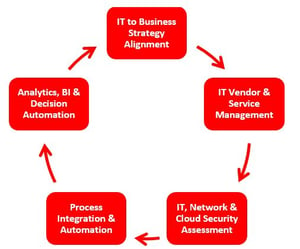Do you want to make business change but can never find the time? See what Consultant Simon Gratton has to say about a Virtual CIO being the answer to your problems...
The modern SME is exceptionally busy and in our experience, has limited time to devote to IT and change activities. In fact, more than 40% of UK businesses under £50M turnover in size, have no in-house IT.
So when you are not big enough to justify a CIO or IT Director, and you are too big not to have digital and IT leadership at the board level, what can you do?
Ladies and Gentlemen, I present your new ‘Virtual CIO’…
“A business consultant who is engaged to work a limited number of hours/days on an on-going basis, both in person and via digital collaboration tools, supporting organisations that either don’t need or cannot afford a full-time CIO.”
This new field of flexible IT leadership is based on a global concept called ‘the Gig Economy’, where high-end, previously inaccessible skills are available on a virtual basis to businesses of any size.
What could a Virtual CIO do for me exactly?
Virtual CIOs are often strategically rather operationally focused on a day-to-day basis, but they will lead, manage, mentor and align permanent team members and IT suppliers across various operational IT and change initiatives.
As an ‘external change agent’, they can be more neutral in their assessment, decision-making, and recommendations than most full-time staff, and are likely to navigate around cultural biases and constraints, bringing the ‘outside-in thinking’ to the forefront of your IT initiatives.
If you are struggling with translating business requirements into executable IT projects, as well as communicating, promoting, and driving complex change across your employee base, or are simply worried about cyber security and GDPR compliance, this type of support could be invaluable.

Virtual CIO Service Cycle (Figure 1)
Our ‘service cycle’ shows typical IT challenges in the SME market today and some of the many ways in which CIO support may help, such as:
- Setting IT strategy and it’s alignment to existing business plans
- Researching, selecting, and negotiating with IT service providers
- Securing and integrating IT and external cloud network infrastructures
- Combining ‘best of breed’ applications into a single view and workflow
- Automating client and product decisions with business-wide intelligence
Avoid being ‘short-changed’ in your critical IT Initiatives!
Virtual CIO IT support fits tremendously well during periods of extreme change within an organisation. Leadership and guidance through difficult decisions that impact your people, processes, and technology, are where the value of this type of experience really comes into its own.
In our experience, immediate accessibility to IT expertise at any point of the day (even when your Virtual CIO is offsite) is also key. New digital video conferencing and mobile collaboration tools are now being adopted by knowledge-workers - somebody who understands the wider picture. This is so they remain connected at all times, can consume up-to-date information, collaborate with team members, and ultimately take the right decisions and actions at the right time.
Do your eyes cloud over when trying to understand IT transformation?
In our experience, here are the most typical ‘change events’ that would benefit from additional IT leadership support and business consultancy within a UK SME business:
- Approaching a period of intense business and culture change
- Considering a change of/or renegotiation with a IT service provider
- Looking to transition existing IT Applications out into a cloud provider
- Planning to optimise highly manual and complex business processes
- Needing to integrate separate systems together operationally
- Hoping to develop a ‘single company view’ using data and analytics tools
- Needing to improve data quality, compliance and data protection status
Does this model impact your ability to develop your own IT team?
Absolutely not, in fact it can often accelerate the creation of IT skills within your business. Mentoring and IT education are a core component of how this type of leadership model operates.
Virtual CIOs are usually experienced mentors, they take the ‘I’ out of CIO and into your team, and are experienced at building teams from scratch in many different types and sizes of institutions. What’s more, they are also experienced at building new IT capabilities leveraging pre-funded models such as government apprenticeships.
Bottom-line double-digit improvements
The beauty of this approach is that high-end IT expertise can be specifically targeted at priority business issues where it matters the most.
So if you are a CEO out there right now with a stuck project; an IT capability that is misaligned with your business strategy; have applications all over the place and none of them are integrated; you need to develop an in-house IT function or simply implement a new cyber-security or GDPR-friendly approach to systems and processes; why not try an experienced ‘Virtual CIO’ for a few days at minimal risk and cost overhead?
After all, you have built your business to prosper and without an effective and integral IT capability you have a lot to lose. IT improvements that are highly aligned to your existing operational pain points can really make a rapid difference to SME businesses in this increasingly digital age.
.png?width=168&name=T-TECH%20logo%20(no%20strapline).png)
